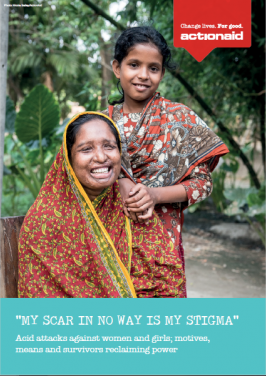"My scar in no way is my stigma" Acid attacks against women and girls; motives, means and survivors reclaiming power
Through the stories of two women this briefing explores why perpetrators use acid violence to target the bodies of women and girls, and what must be done to prevent it.
Executive summary
Violence against women and girls (VAWG) is the world’s most widespread human rights abuse. Physical and sexual abuse affects one third of women globally, most likely at the hands of an intimate partner. VAWG happens everywhere and takes many forms: intimate partner violence, sexual harassment, rape, sexual assault, denial of resources, psychological or emotional abuse, intimidation, child marriage, FGM – are just some examples. Whatever the form, violence that targets women and girls is rooted in pervasive patriarchal norms, restricting women’s and girls’ control over their bodies and lives.
To have full control over your body is a fundamental and basic human right. At ActionAid we use the term bodily integrity which we believe encompasses women’s and girls’ right to live free from violence, the right to freedom of movement, and the right to sexual and reproductive choice. Unfortunately acid attacks are not a new phenomenon. Corrosive materials have been used to disfigure women and girls for more than two hundred years. It is an extreme form of violence and uses an extreme weapon. It is not restricted to one particular group and can affect women and girls regardless of their race, religion, class, sexuality or geographical location.
The increased attention on acid attacks in the UK is welcome given that the recorded number of attacks has more than doubled in the past five years. In Britain, this rise has been attributed to male gang members, predominantly in London, favouring acid as a weapon because it is more easily available and bound by fewer legislative controls than knives and guns. The global picture however shows that acid violence disproportionately affects women and girls. This briefing focuses on the global situation. It examines why women and girls are targeted, the perpetrators’ motives and what needs to be done to support survivors and bring an end to acid violence.
